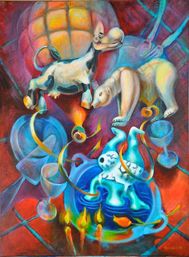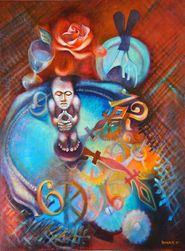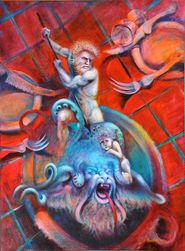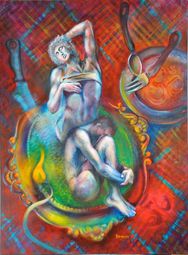The Dining Table Epergine Series 2008
Acrylic on canvas 101 x 76 cm (40" x 30")
Artist's Statement - The Dining Table Series 2008
|
This series of paintings focuses on the Centrepiece of the Dining Table.
The Dining Table is a location for shared social experience where people regularly gather, dine and talk about significant issues in life. It is place where views are established and power structures are entrenched and may be considered to be at the very heart of our lives and a microcosm of Society. The Centerpiece (Epergne) is used as a versatile serving dish for the Dining Table. It may be either functional or decorative, made in numerous designs and also used as a symbol of wealth and prestige. In these Paintings: The Centerpiece is transposed from its historical origins to a conceptual level where the diners at the Dining Table are faced with societal, humanitarian or philosophical issues as presented by the individual Centrepiece. The viewer looking from above sees the Centrepiece, with the Dining Table as a backdrop. The table cloth has a diagonal pattern with some evidence of dining (plates, cutlery, and glasses) but the main imagery is associated with the Centerpiece which reflects the thoughts, aspirations and ambitions of one or more of the people who may be gathered around the Dining Table. The Table of Celebration
The imagery of this Centrepiece is based on contemporary sculptures and hot air balloons in figurative forms. This painting is a lighthearted look at celebration and escape from the mundanity of the Dining Table and the regimentation imposed by the social mores of society.
The Table of Time.
The imagery of this Centrepiece is associated with the effects of the passage of time on the Dining Table (which represents a microcosm of society). The Centrepiece (serving dish) on the table cloth is shown as a clock face with a meditative figure at the centre of time. Viewing from top left to bottom right on the painting, the Centrepiece symbolizing the ordered nature of society, is shown breaking down as is the very table cloth on which it is set.
The Table of Power
The imagery of this Centrepiece is based on classical figurative sculpture. Interpretations can range from the eternal struggles of humanity within a societal structure such as the battle between good and evil, the strong and the weak or the relative power relationships within the family structure. In the painting one could also consider that:
The Table of Contemplation
The imagery of this Centrepiece is based on classical figurative sculpture and poses. The imagery reflects contemplation on the meaning of life. What is and what might have been. In the painting the three figures represent views on the past, present and future of humanity. The two figures as a Centerpiece are part of the full world (the Dining Table) and yet isolated from that world as they are immersed in their own thoughts, actions and ambitions. They may consider:
|



